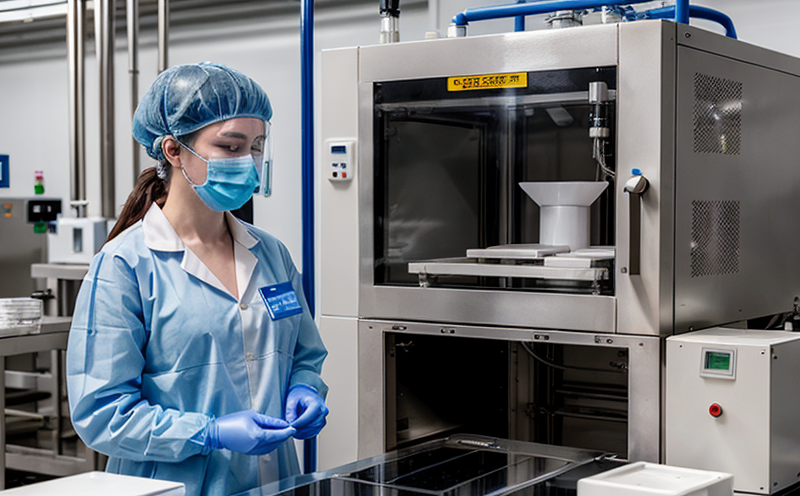GMP Endotoxin Testing of Water Systems
Good Manufacturing Practice (GMP) Compliance Testing is critical in pharmaceutical manufacturing to ensure that products meet strict regulatory standards and are safe for use. GMP endotoxin testing specifically focuses on the presence of endotoxins, which can be harmful contaminants derived from certain microorganisms like bacteria. This testing ensures water used in pharmaceutical processes meets stringent requirements.
Water systems play a vital role in drug production by providing clean, sterile water necessary for various manufacturing steps, including formulation, cleaning, and sterilization. Any contamination in these water systems could lead to product defects or even safety issues. Therefore, ensuring the absence of endotoxins is paramount to maintaining GMP compliance.
The testing process involves several key steps:
- Sampling: Water samples are collected from various points within the system using appropriate containers designed not to introduce contaminants.
- Preparation: Samples are prepared according to ISO 11737-2, which outlines procedures for endotoxin testing of water and other liquids used in pharmaceutical manufacturing.
- Testing: The samples undergo a chromogenic method (ISO 11737-4) or LAL-based assays that detect the presence of endotoxins by their interaction with Limulus amebocyte lysate.
- Reporting: Results are compiled into detailed reports outlining compliance with regulatory standards and any necessary corrective actions.
The importance of this testing cannot be overstated. Regulatory bodies like the FDA, EMA, and WHO have stringent requirements for water systems in pharmaceutical manufacturing processes to ensure product quality and safety. Non-compliance can lead to product recalls, fines, and reputational damage.
Our laboratory employs state-of-the-art equipment and adheres strictly to international standards such as ISO 11737-2, -4, ASTM E2850, and EN 16797. This ensures accurate, reliable, and repeatable results that meet the highest regulatory standards.
In summary, GMP endotoxin testing of water systems is a critical step in pharmaceutical manufacturing to ensure product safety and compliance with stringent regulations. It helps identify potential risks early on, allowing for timely corrective actions. By partnering with our laboratory, you can rest assured that your water systems are continuously monitored and maintained at the highest standards.
Industry Applications
- Pharmaceutical Manufacturing: Ensuring compliance with GMP regulations for drug production processes.
- Cosmetics Industry: Testing water used in formulation and production to ensure product safety.
- Biotechnology: Monitoring water quality in bioreactor systems to prevent contamination.
- Agricultural Biotech: Ensuring the safety of irrigation water for genetically modified crops.
In each of these industries, ensuring the absence of endotoxins is critical. Our testing services are designed to meet the specific needs of various sectors, providing accurate and reliable results that can be trusted by regulatory bodies worldwide.
Why Choose This Test
The decision to conduct GMP endotoxin testing on water systems is driven by several factors:
- Regulatory Compliance: Ensures adherence to international standards like ISO 11737-2 and FDA regulations.
- Product Safety: Identifies potential contaminants that could harm patients or consumers.
- Risk Management: Helps in identifying and mitigating risks early, reducing the likelihood of product recalls.
- Quality Assurance: Provides assurance that water used in manufacturing processes meets the highest quality standards.
GMP endotoxin testing is a proactive measure that can prevent costly mistakes and ensure consistent product quality. By choosing our laboratory for this service, you gain access to expert knowledge and cutting-edge technology, ensuring your compliance efforts are both efficient and effective.
Competitive Advantage and Market Impact
In today's competitive pharmaceutical market, maintaining GMP compliance is not just a requirement but a strategic advantage. By demonstrating your commitment to quality through rigorous testing protocols, you can differentiate yourself from competitors. This ensures that your products meet the highest standards of safety and reliability, thereby enhancing customer trust.
GMP endotoxin testing also supports innovation in pharmaceutical manufacturing by providing data-driven insights into process improvements. This allows companies to optimize their operations, leading to more efficient production processes and reduced costs. In a highly regulated industry, being able to demonstrate compliance with stringent standards is critical for gaining market share and maintaining a strong reputation.
Our laboratory's expertise in GMP endotoxin testing not only supports compliance but also contributes to the overall success of your business by ensuring that every aspect of your manufacturing process meets the highest standards. This can lead to enhanced product quality, reduced risks, and improved customer satisfaction—all key factors in achieving a competitive edge.





